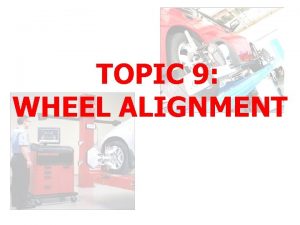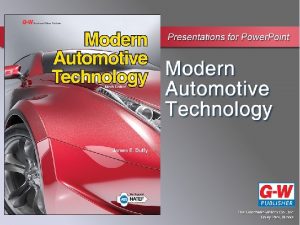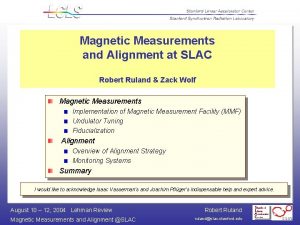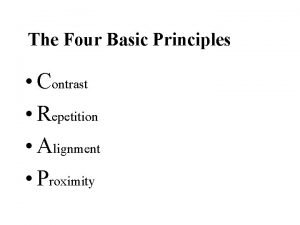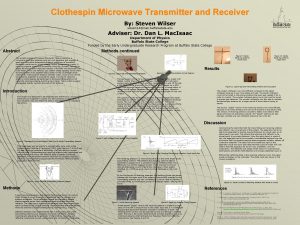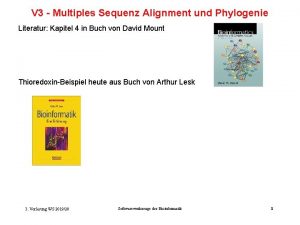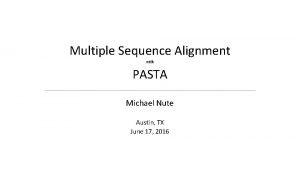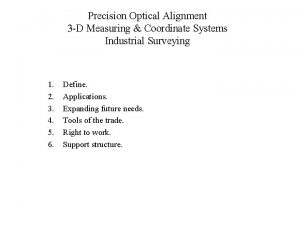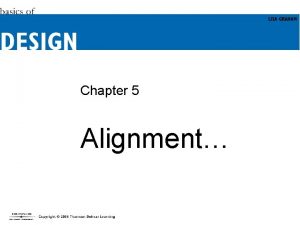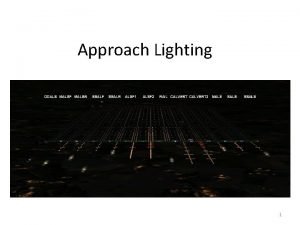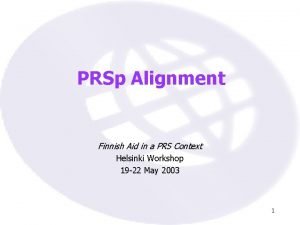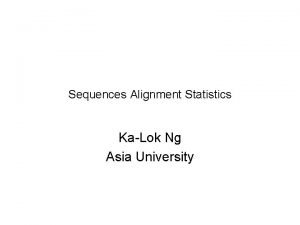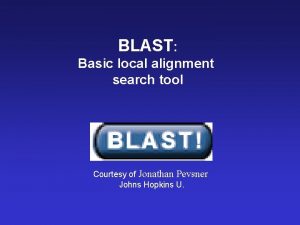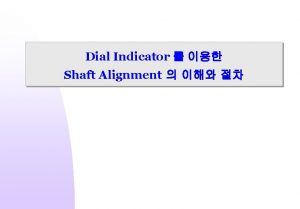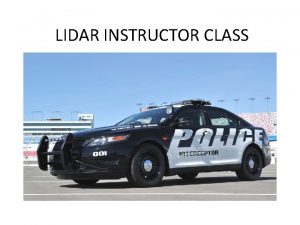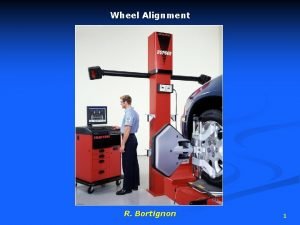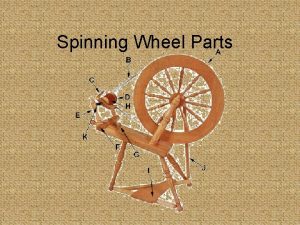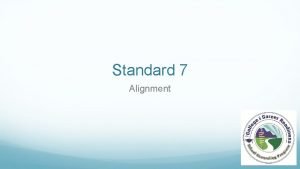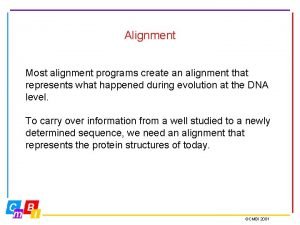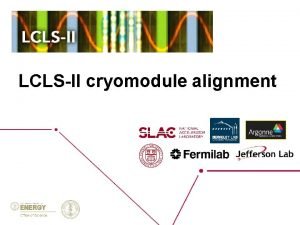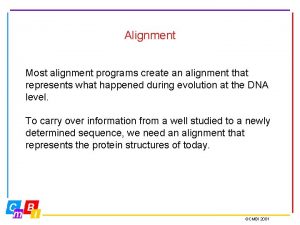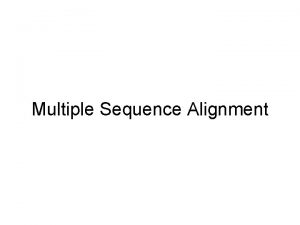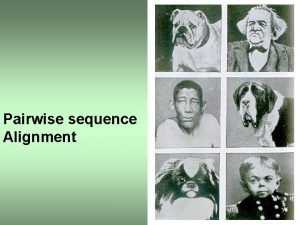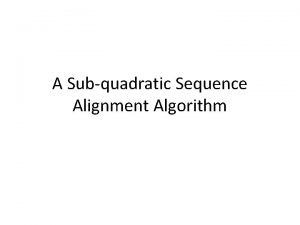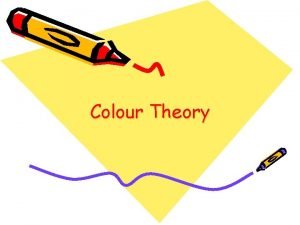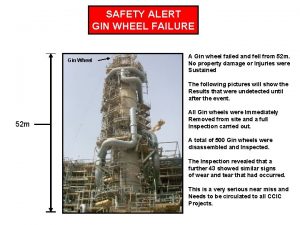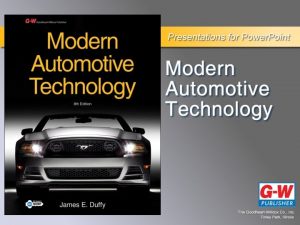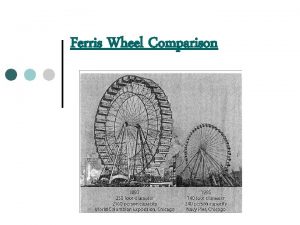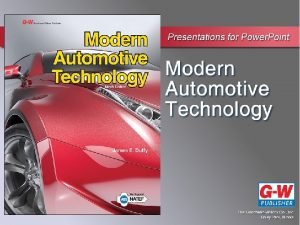TOPIC 9 WHEEL ALIGNMENT e W h l






























- Slides: 30

TOPIC 9: WHEEL ALIGNMENT

e W h l e e A il g m n t n

OBJECTIVES: Explain how camber, caster, and toe affect the handling and tire wear of the vehicle. A wheel alignment is the adjustment of the suspension and steering to ensure proper vehicle handling with minimum tire wear. When a vehicle is new, the alignment angles are set at the factory. After many miles and/or months of driving, the alignment angles can change slightly. By adjusting the suspension and steering components, proper alignment angles can be restored. An alignment includes checking and adjusting, if necessary, both front and rear wheels.

ALIGNMENT-RELATED PROBLEMS Most alignment diagnosis is symptom-based diagnosis. The problem with the alignment is determined from symptoms such as excessive tire wear or a pull to one side of the road. Pull Defined as a definite tug on the steering wheel or pull toward the left or the right while driving straight on a level road. A pull is usually defined as a tug on the steering wheel toward one side or the other. Bent, damaged, worn suspension and/or steering components or tire problems can cause this.

Road Crown Effects Most roads are constructed with a slight angle to permit water to drain from the road surface. On a two-lane road, the center of the road is often higher than the berms, resulting in a road crown. The crown of the road refers to the angle or slope of the roadway needed to drain water off the pavement.

Wander A condition where constant steering wheel corrections are necessary to maintain a straight-ahead direction on a straight, level road is called wander. Worn suspension and/or steering components are the likely cause of this condition. Incorrect or unequal alignment angles such as caster and toe, as well as defective tire(s), can cause this condition. Wander is an unstable condition requiring constant driver corrections.

CAMBER Camber: is the inward or outward tilt of the wheels from true vertical as viewed from the front or rear of the vehicle. Positive camber. The solid vertical line represents true vertical; the dotted line the angle of the tire. Negative camber. The solid vertical line represents true vertical; the dotted line the angle of the tire. Zero camber. Note the angle of the tire is true vertical.

included angle causes scuffing and wear on the outside edge of the tire

Excessive negative camber causes scuffing and wear on the inside edge of the tire,

Incorrect camber can cause excessive wear on wheel bearings. Many vehicle manufacturers specify positive camber so the vehicle’s weight is applied to the larger inner wheel bearing and spindle. Positive camber applies the vehicle weight toward the larger inner wheel bearing. This is desirable because the larger inner bearing is designed to carry more vehicle weight than the outer bearing. Negative camber applies the vehicle weight to the smaller outer wheel bearing. Excessive negative camber, may contribute to outer wheel bearing failure.

Caster: is the forward or rearward tilt of the steering axis in reference to a vertical line as viewed from the side of the vehicle. The steering axis is defined as the line drawn through the upper and lower steering pivot points. Zero caster means the steering axis is straight up and down. Zero caster.

Caster Positive (+) caster Negative (–) caster is seldom specified on today’s vehicles because it tends to make the vehicle unstable at highway speeds. Negative caster was specified on some older vehicles not equipped with power steering to help reduce the steering effort.

Toe is the difference in distance between the front and rear of the tires. As viewed from the top of the vehicle (a bird’s eye view), zero toe means that both wheels on the same axle are parallel, as shown: Zero toe. Note how both tires are parallel to each other as viewed from above the vehicle.

Toe is also described as a comparison of horizontal lines drawn through both wheels on the same axle, as shown here. Total toe is often expressed as an angle. Because both front wheels are tied together through the tie rods and center link, the toe angle is always equally split between the two front wheels when the vehicle moves forward.

If the front of the tires is closer than the rear of the same tires, then the toe is called toe-in or positive (+) toe. Toe-in, also called positive (+) toe.

If the front of the tires is farther apart than the rear of the same tires, then the wheels are toed-out, or have negative (–) toe. Toe-out, also called negative (–) toe. Some manufacturers of front-wheel-drive vehicles specify a toe-out setting to compensate for the toe-in forces created by the engine drive forces on the front wheels.

The purpose of correct toe setting is to provide maximum stability with a minimum of tire wear when the vehicle is being driven. Incorrect toe is the major cause of excessive tire wear! This tire is just one month old! It was new and installed on the front of a vehicle that had about 1/4 inch (6 mm) of toe-out. By the time the customer returned to the tire store for an alignment, the tire was completely bald on the inside. Note the almost new tread on the outside. Continued

If the toe is improper by just 1/8 in. (3 mm), the resulting tire wear is equivalent to dragging a tire sideways 28 feet (8. 5 m) for every mile traveled (1. 6 km). NOTE: If not correct, toe causes camber-type wear on one side of the tire. Excessive toe-out and the type of wear that can occur to the inside of the left front tire.

Feather-edge wear is also common, especially if the vehicle is equipped with nonradial tires. Feather-edge wear pattern caused by excessive toe-in or toe-out. Excessive toe-in and the type of wear that can occur to the outside of the left front tire.

Rear toe-in (+). The rear toe (unlike the front toe) can be different for each wheel while the vehicle is moving forward because the rear wheels are not tied together as they are in the front. Incorrect toe can cause the tire to run sideways as it rolls, resulting in a diagonal wipe. Diagonal wear such as shown here is usually caused by incorrect toe on the rear of a front-wheel-drive vehicle.

STEERING AXIS INCLINATION (SAI) The steering axis is the angle formed between true vertical and an imaginary line drawn between the upper and lower pivot points of the spindle. Steering axis inclination (SAI) is the inward tilt of the steering axis. SAI is also known as kingpin inclination (KPI) and is the imaginary line drawn through the kingpin as viewed from the front. SAI is also called ball joint inclination (BJI), if SLA-type suspension is used, or Mac. Pherson strut inclination (MSI). Continued

STEERING AXIS INCLINATION (SAI) The left illustration shows that the steering axis inclination angle is determined by drawing a line through the center of the upper and lower ball joints. This represents the pivot points of the front wheels when the steering wheel is rotated during cornering. The right illustration shows that the steering axis inclination angle is determined by drawing a line through the axis of the upper strut bearing mount assembly and the lower ball joint.

INCLUDED ANGLE The included angle is the SAI added to the camber reading of the front wheels only. Included angle on a Mac. Pherson-strut-type suspension. The included angle is determined by the design of the steering knuckle, or strut construction.

Included angle is an important angle to measure for diagnosis of vehicle handling or tire wear problems. If the cradle is out of location due to previous service work or an accident, knowing SAI, camber, and included angle can help in determining what needs to be done to correct the problem. If the included angles are equal side-to-side, but the camber is unequal on both sides, the SAI must be unequal. For best handling, the included angle should be within 1/2 degree of the SAI of the other side of the vehicle. Cradle placement. If the cradle is not replaced in the exact position after removal for a transmission or clutch replacement, the SAI, camber, and included angle will not be equal side-to-side.

TURNING RADIUS (TOE-OUT ON TURNS) When a vehicle turns a corner, the inside wheel has to turn at a sharper angle than the outside wheel because the inside wheel has a shorter distance to travel. Turning radius, a nonadjustable angle, is called toe-out on turns, TOT or TOOT. It is determined by angle of the steering knuckle arms, and should be measured to check if the steering arms are bent or damaged. Symptoms of out-of-spec turning angle include: 1. Tire squeal noise during normal cornering, even at low speeds 2. Scuffed tire wear To provide handling, the inside wheel has to turn at a greater turning radius than the outside wheel.

The proper angle of the steering arms is where imaginary lines drawn from the steering arms should intersect exactly at the center of the rear axle. This angle is called the Ackerman Effect (named for its promoter, English publisher, Rudolph Ackerman, ca. 1898). The proper toe-out on turns is achieved by angling the steering arms.

SETBACK Setback is the angle formed by a line drawn perpendicular (at 90 degrees) to the front axles. (a) Positive setback means the right front wheel is set back farther than the left (a) Positive setback. (b) negative setback means the left front wheel is set back farther than the right. (b) Negative setback.

The causes of setback include the following: 1. Cradle placement not correct on a front-wheel-drive vehicle. This can be caused by incorrectly installing the cradle after a transmission, clutch, or engine replacement or service. 2. An accident that affected the frame or cradle of the vehicle and was unnoticed or not repaired Cradle placement affects setback.

THRUST ANGLE On vehicles with an independent rear suspension, if both wheels do not have equal toe, the vehicle will pull in the direction of the side with the most toe-in. (a) Zero thrust angle. (b) Thrust line to the right. (c) Thrust line to the left. If both rear wheels have zero toe, then the thrust angle is the same as the geometric centerline of the vehicle. The total of the rear toe setting determines the thrust line, or the direction the rear wheels are pointed.

TRACKING (a) (b) Proper tracking. Front wheels steering toward thrust line. The rear wheels should track directly behind the front wheels. If the vehicle has been involved in an accident, it is possible that the frame or rear axle mounting could cause dog tracking.
 Global alignment
Global alignment Global vs local alignment
Global vs local alignment Dna substitution
Dna substitution Global alignment vs local alignment
Global alignment vs local alignment Alignment score in bioinformatics
Alignment score in bioinformatics Wheel alignment angles
Wheel alignment angles Steering axis inclination angle
Steering axis inclination angle Example of a clincher
Example of a clincher Narrowed down topic examples
Narrowed down topic examples What is the slender tool attached in the needle clamp
What is the slender tool attached in the needle clamp Tire wheel and wheel bearing fundamentals
Tire wheel and wheel bearing fundamentals Chapter 73 tire wheel and wheel bearing fundamentals
Chapter 73 tire wheel and wheel bearing fundamentals Cradle alignment techniques
Cradle alignment techniques Contrast alignment repetition proximity
Contrast alignment repetition proximity Microwave path alignment kit
Microwave path alignment kit Image alignment and stitching
Image alignment and stitching Quadile alignment technique
Quadile alignment technique Curriculum alignment example
Curriculum alignment example Sequenz alignment
Sequenz alignment Nutes noodles
Nutes noodles Hirschberg's algorithm
Hirschberg's algorithm Precision optical alignment equipment
Precision optical alignment equipment Runaround text alignment
Runaround text alignment Alsf 1
Alsf 1 Temporal alignment
Temporal alignment Direction alignment commitment
Direction alignment commitment Pairwise alignment
Pairwise alignment Blast basic local alignment search tool
Blast basic local alignment search tool Microscope alignment
Microscope alignment Types of misalignment
Types of misalignment Alignment test
Alignment test






